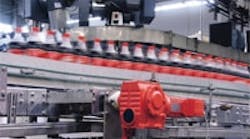“Green” means different things to different people. For most, it refers to energy efficiency, and that's probably the easiest way to think about it: Minimize inefficiencies and losses to maximize energy savings. Many of these losses are electrical, but don't forget about mechanical losses due to unnecessary friction — an often-overlooked opportunity for saving energy. Another way to make designs greener is by eliminating components, especially disposable or “wear” items, and even more so if those wear items are petroleum-based or produced in a way that adds toxins to air, water, or soil.
But how can a gearmotor go green? Let's take a look at its major parts and find out. For starters, a gearmotor by its very nature is inherently greener than a separate gear unit and motor connected by a belt, chain, coupling, or other flexible transmission element. Why? Because the gearmotor eliminates these components altogether. And not only once — those items wear and require replacement, not to mention the time required to perform this maintenance.
Another point to consider: Flexible transmission elements all have more inefficiency than the precise, rigid motor-to-gear connection of a gearmotor. Consider a V-belt. Because a V-belt transmits torque via friction, and we know that friction equals losses, we can rightly deduce that use of a V-belt equals losses. One popular belt manufacturer states that although V-belts are 95% to 98% efficient at installation, they lose 5% just after installation. So that's 90% to 93% efficiency right off the bat. This manufacturer also states that the belt will lose up to 10% more during its 20,000-hour lifespan due to stretching, unless it is regularly retensioned. Because I'm certain that conscientious maintenance crews regularly retension all those slipping belts, we'll just call it 5%. Translation: During the majority of the belt's lifetime, efficiency is between 85% and 88%. Using a toothed belt? Credit yourself two percentage points.
By contrast, the gearmotor has rigid transmission elements. Everything is positively and rigidly connected inside the unit with perfect and permanent alignment. This means that the efficiency of the motor-to-gear connection in a gearmotor is 100%. Therefore, the initial choice of a gearmotor over belt-connected elements yields a 12% to 15% increase in efficiency. And don't forget the savings in materials of replacement belts. We won't mention the time it takes to retension and replace belts, because that's free, right?
Motors and gears
What about the gearmotor itself? Let us consider the main sections of the gearmotor: the motor and the gears. Lately there's been a lot of buzz about energy-efficient motors. In fact, we are privileged to live in an age where the industrial workhorse ac induction motor is finally getting its hour in the spotlight. Motor manufacturers have introduced truly miraculous efficiency gains for ac induction motors. Motors that meet the new NEMA Premium efficiency level are generally 2% to 5% more efficient than EPAct motors, and they may be as much as 20% higher than pre-EPAct models. So, when you specify a gearmotor, be sure to consider the efficiency choices that your supplier offers. Chances are they have several options from which to choose based on your other application requirements — such as productivity, reliability, and safety.
A bit of caution is in order: If you use ac motors in high-cycling applications, your preferred manufacturer may not offer a premium-efficient product that can handle high cycling. In fact, many are limited to less than 50 starts per hour, and some are even as low as two or three. In addition, if you are dealing with cycling applications, know that a premium-efficient motor may have a higher efficiency rating than your old motor, but it may not really save energy. Higher efficiency sometimes comes at the price of higher rotor inertia; in some applications, especially those with frequent starts, the total amount of energy used may actually be higher with a premium-efficient motor. Do the math so you can compare the overall energy use of different solutions. Many manufacturers offer software tools to help with that.
Last, but certainly not least, is the gear train itself. Consider that the most common gear technology is the worm gear. Why? Mostly because it's a lot less expensive than other types. But if you want to green-up your power train, this is the best place to do it. High-ratio, single-worm reducers usually offer 60% to 70% efficiency. Compare this to helical bevel reducers that are around 95% efficient. That's more improvement than you could ever get replacing an old motor with a new one.
Bottom line: Anyone can buy a green product. But just buying green products is not your goal. Quality engineering means selecting and integrating the right products for the job.
This article's handy tips courtesy Rich Mintz.



